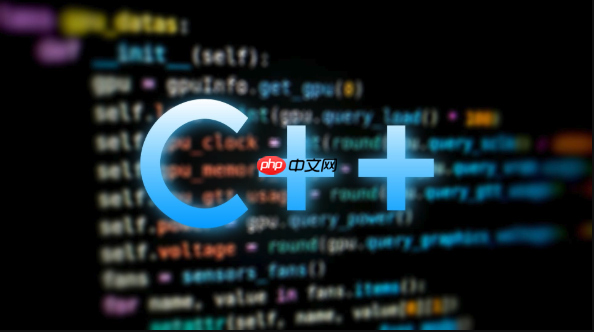std::move通过将左值转换为右值引用,启用移动语义,避免深拷贝,提升性能。

在C++中,std::move 并不是真正“移动”对象,而是将一个左值强制转换为右值引用,从而允许调用移动构造函数或移动赋值操作符。它的核心作用是**启用移动语义**,避免不必要的深拷贝,提升性能。
要正确使用 std::move,首先要理解几个基本概念:
std::move 的作用就是把一个左值“标记”为右值,告诉编译器:“这个对象后续不再使用,可以安全地移动它”。
std::move 定义在 <utility> 头文件中,使用方式如下:
立即学习“C++免费学习笔记(深入)”;
std::move(对象) 返回该对象的右值引用。
常见使用场景:
示例代码:
#include <iostream>
#include <vector>
#include <utility>
<p>class MyString {
public:
char* data;</p><pre class="brush:php;toolbar:false;"><pre class="brush:php;toolbar:false;">// 构造函数
MyString(const char* str) {
data = new char[strlen(str) + 1];
strcpy(data, str);
}
// 移动构造函数
MyString(MyString&& other) noexcept {
data = other.data; // 转移指针
other.data = nullptr; // 防止原对象释放同一内存
}
// 析构函数
~MyString() {
delete[] data;
}
// 禁用拷贝以简化示例
MyString(const MyString&) = delete;
MyString& operator=(const MyString&) = delete;};
int main() { MyString str1("Hello"); MyString str2 = std::move(str1); // 调用移动构造函数
// 此时 str1.data 已被置空,不应再使用 std::cout << (str1.data == nullptr ? "str1 is empty" : str1.data) << "\n"; std::cout << str2.data << "\n"; // 输出: Hello return 0;
}
在这个例子中,std::move 将 str1 转换为右值,从而调用移动构造函数,避免了内存的深拷贝。
std::vector 等标准容器在扩容或插入元素时,会优先使用移动而非拷贝(如果移动构造函数可用)。
例如:
std::vector<std::string> vec; std::string temp = "This is a long string that would be expensive to copy"; <p>vec.push_back(std::move(temp)); // 移动而不是拷贝 // 此时 temp 变为空字符串,不应再使用
这样可以显著提高性能,特别是对于大对象或频繁操作的场景。
基本上就这些。std::move 是实现移动语义的关键工具,合理使用能显著提升程序效率,但需注意语义安全和对象状态管理。
以上就是C++如何使用std::move_C++对象转移与std::move使用方法的详细内容,更多请关注php中文网其它相关文章!

每个人都需要一台速度更快、更稳定的 PC。随着时间的推移,垃圾文件、旧注册表数据和不必要的后台进程会占用资源并降低性能。幸运的是,许多工具可以让 Windows 保持平稳运行。

Copyright 2014-2025 https://www.php.cn/ All Rights Reserved | php.cn | 湘ICP备2023035733号